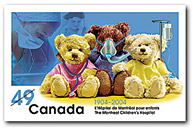The Century Club (Page 3)
100 Years of Children's Medicine

Tots receive some attentive and loving care at the Montreal Children’s Hospital, circa 1950.
On a cold January 30th, 1904, five children passed through the doors at 500 Guy Street, the first patients of the Children's Memorial Hospital. The hospital (the "Memorial" was for Queen Victoria, who had died in 1901) was quickly filled to its ten-person capacity, and in the summer, patients were sometimes cared for in tents erected in a neighbour's garden - a space-saving compromise that took advantage of the healthy effects of fresh air and sunshine. As a result of space demands and a growing belief in the importance of pediatric care, a new hospital was built on Cedar Avenue in 1909, and in 1920 the institution became a McGill teaching hospital.
The first hospital devoted to pediatric care in the city, and fully bilingual from the start, the Children's Memorial Hospital was the result of energy and advocacy on the part of its founders, particularly Dr. Alexander Forbes, who rented the Guy Street building, and Dr. Harold Cushing, who later was the first head of McGill's pediatrics department.
Advocacy and energy have continued to figure prominently in the institution's impressive 100-year portfolio. In 1932 the world's first respirator - ancestor to the "iron lung" - was designed at the hospital; the following year saw the first speech therapy program in a Canadian pediatric hospital; and over its history the hospital has seen numerous innovations and "firsts" in areas such as cardiac surgery for children. The current location on Tupper Street has been home since 1956, when a name change to the Montreal Children's Hospital accompanied the move. And in 1997, the MCH became part of the McGill University Health Centre (MUHC).
Age shows no sign of slowing down activity or progress at the 180-bed facility. Each year, 70 outpatient clinics and programs respond to around 155,000 visits - one of the highest volumes in pediatric ambulatory care in North America. And in 2002, its surgeons used a mechanical heart device as a bridge for a cardiac transplant on the youngest patient in North America.

A stamp issued in honour of the Children’s Hospital centennial.
Of course, the success of a children's hospital depends not only on cutting-edge practice but also on the ability of its staff to connect well with its young patients. As Wendy MacDonald, BSc'66, MDCM'70, director of the Faculty of Medicine's undergraduate pediatric program, says, "The ambiance at the MCH is unique. Everyone here enjoys working with children. It's impossible to feel jaded when you come to work and meet these beautiful infants and young children."
Helping to connect staff and patients is a hospital-wide multiculturalism program established 20 years ago - another first in Canada - to serve the one-third of families who speak neither English nor French. A roster of staff volunteers can be called on to assist with translation in up to 50 languages and dialects. The award-winning program also sensitizes staff to cross-cultural issues as they affect health care and now includes a Multicultural Clinic and the Transcultural Psychiatric Clinic.
Naturally, a century of patient care and professional accomplishments are not going unobserved. "The celebrations began at the end of January, 100 years to the day since the first five patients were admitted," says Dr. Hy Goldman, Chair of the Centennial Committee, who has practised at the MCH since 1959 and is also an associate professor in pediatrics.
A sold-out gala featuring physician and social activist Dr. Patch Adams kicked off the centenary. For the following ten months, the MCH has filled its academic and social agenda, with 70 events until the mid-December "Fête Folie" Family Party at the Chalet on Montreal's Mount Royal. A brief sampling: over the summer, the MCH sponsored two teams in local dragon boat races; hosted a session at the International Congress of Immunology; and on June 21, National Aboriginal Day, erected two inukshuks, representing an adult and a child, outside the MCH in recognition of its involvement with Native and northern communities. Other events included a September golf tournament and a Sports Celebrity Dinner at the Bell Centre. In addition, the MCH figures prominently in "Growing Up in Montreal," a major exhibit which started in October at the McCord Museum.
In the next few years, the Children's could be transformed again, depending on the MUHC plans to create one large hospital complex. "We're part of the package, but right now we're not certain what the package will look like," says Goldman. In the meantime, though, the MCH is on the leading edge of medical treatment and teaching, with an international reputation in cardiac surgery, neurosurgery and reconstructive surgery, as well as specialized multidisciplinary care and critical-care programs.
But while its reputation among pediatric professionals is assured, this renown hasn't yet translated into local fame. "We have had a low profile over the years," says says Goldman. In the meantime, though, the MCH is on the leading edge of medical treatment and teaching, with an international reputation in cardiac surgery, neurosurgery and reconstructive surgery, as well as specialized multidisciplinary care and critical-care programs.
But while its reputation among pediatric professionals is assured, this renown hasn't yet translated into local fame. "We have had a low profile over the years," says Goldman. "We've been innovative, but not PR conscious. So our celebrations are two-pronged, both to illustrate who we are and what we've done, and to bring us to the public eye. The centennial is a coming-out party."
For more information about the Montreal Children's Hospital and its centenary see www.mch2004.com and www.thechildren.com.


